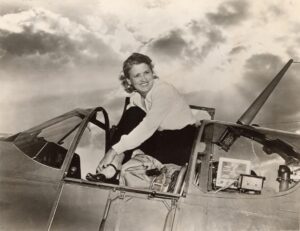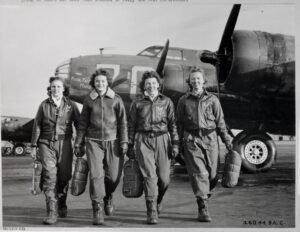Jacqueline Cochran, a name etched in the annals of aviation history, was not just a pioneering pilot; she was an indomitable force that blazed trails through the sky. While many know her as a record-breaking aviator, her life was an intricate tapestry of remarkable stories that deserve to be celebrated. In this blog post, we’ll uncover six captivating aspects of Jacqueline Cochran’s life, from her entrepreneurial spirit to her role in the early space program.
Entrepreneurial Early Life of Jacqueline Cochran
Born as Bessie Mae Pittman in DeFuniak Springs, Florida, Cochran was destined to live life on her terms. At the tender age of 10, she boldly left her job in the cotton mills to work at a beauty salon. Her journey led her to briefly study nursing, but her spirit pushed her back to the world of hairdressing. By the early 1930s, she had climbed the ranks to work at Antoine’s salons in the prestigious Saks Fifth Avenue stores in New York City and Miami. Interestingly, Cochran publicly maintained that she was an orphan while secretly staying in contact with her Pittman family.
How She Started to Fly

Jacqueline Cochran’s entry into the world of aviation was unconventional, to say the least. It was her future husband, Floyd Odlum, who suggested she learn to fly to promote their business venture. In 1932, she embarked on this daring journey, soloing at Roosevelt Flying School on Long Island after just three weeks of lessons. Her passion for flying soared, leading her to advanced instruction at the Ryan School of Aeronautics. She earned her instrument rating, commercial, and transport pilot licenses. Her courage knew no bounds.
Flying, Cosmetics, and Setting Records
In 1935, Cochran expanded her horizons into the cosmetics industry by establishing “Jacqueline Cochran Cosmetics, Wings of Beauty.” She competed successfully with established beauty houses like Helena Rubenstein and Elizabeth Arden. What’s intriguing is that, despite her rigorous flying schedule, she managed to fly around the country delivering test products and building a network of distributors. Her relentless spirit even led her to create a moisturizer to combat dry skin caused by high-altitude flights. Cochran’s insistence on looking impeccable after flights was not only a personal preference but also a statement against the prevailing perception of women pilots.
Jacqueline Cochran Setting Aviation Records
Jacqueline Cochran was not content with breaking the mold; she aimed to shatter records. In 1937, she set two women’s speed records in her Beech D-17W Staggerwing. But she didn’t stop there. Cochran went on to break three major flying records, not just in women’s categories but also in men’s. Her crowning achievement was winning the prestigious 1938 Bendix Trophy Race, piloting Alexander de Seversky’s P-35 pursuit plane after three tenacious attempts.
World War II and Forming the WASP
As World War II loomed over Europe, Jacqueline Cochran was among those who believed women should play a pivotal role in wartime aviation. In 1941, she handpicked 27 highly qualified U.S. women pilots to ferry military aircraft in Great Britain for the Air Transport Auxiliary (ATA). In 1942, at the request of Army General Henry “Hap” Arnold, she organized the Women’s Flying Training Detachment (WFTD) to train civilian women pilots in anticipation of a domestic shortage of American military pilots. The WFTD merged with Nancy Love’s Women’s Auxiliary Ferry Squadron (WAFS) to form the Women Airforce Service Pilots (WASP), with Cochran as its director. These fearless women flew over 60 million miles, ferrying aircraft, towing targets, and performing critical transport duties. Despite disbandment in 1944, Cochran’s unwavering leadership eventually led to the WASP receiving retroactive military status in 1977.
Jacqueline Cochran and the Early Space Program
Cochran’s influence extended to the early space program as well. She supported the Lovelace Clinic’s Woman in Space Program in 1960-1961, which offered rigorous medical testing to highly-qualified female pilots, mirroring the NASA tests for male astronauts. Thirteen women successfully passed these tests. However, NASA was not yet ready to include women in the space program. Jacqueline Cochran’s complex stance on women as prospective astronauts or commercial airline pilots was a testament to her multifaceted personality.
Wrapping It Up
Jacqueline Cochran’s life was a symphony of audacity, resilience, and triumph. Her entrepreneurial spirit, record-setting flights, pivotal role in World War II, and involvement in the early space program make her an icon of aviation. Her legacy reminds us that with unwavering determination, we can soar to unimaginable heights, break barriers, and leave an indelible mark on history. Jacqueline Cochran, the soaring pioneer, will forever inspire us to reach for the stars. That’s it for this weeks blogs, until next time, Be Social, Fly Private !

